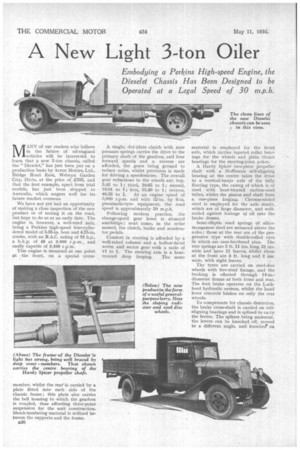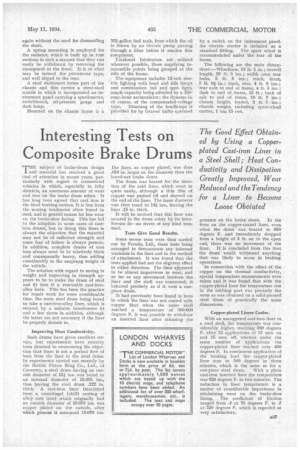A New Light 3-ton Oiler
Page 44

Page 45

If you've noticed an error in this article please click here to report it so we can fix it.
Embodying a Perkins High-speed Engine, the Dieselet Chassis Has Been Designed to be Operated at a Legal Speed of 30 m.p.h.
MANY of our readers who believe in the future of oil-engined vehicles will be interested to learn that a new 3-ton chassis, called the " Dieselet," has just been put on a production basis by Arran Motors, Ltd., Bridge Road East, Welwyn Garden City, Herts, at the price of £555, and that the first example, apart from trial models, has just been shipped to Australia, which augurs well for its future market overseas.
We have not yet had an opportunity of making a close inspection of the new product or of testing it on the road, but hope to do so at an early date. The engine is, however, a well-tried unit, being a Perkins high-speed four-cylindered model of 3.35-in, bore and 4.75-in. stroke, with an R.A.C. rating of 18 h.p., a b.h.p. of 48 at 3,000 r.p.m., and easily capable of 3,500 r.p.m.
This engine is mounted at one point at the front, on a special 'cross member, whilst the real is carried by a plate fitted into each side of the chassis frame ; this plate also carries the bell housing to which the gearbox is coupled, thus affording three-point suspension for the unit construction. Shock-insulating material is utilized between the supports and the frame.
B26 A single, dry-plate clutch with nine pressure springs carries the drive to the primary shaft of the gearbox, and four forward speeds, and a reverse are afforded, the gears being ground to reduce noise, whilst provision is made for driving a speedometer. The overall gear reductions to the wheels are: top, 5.85 to 1; third, 10.65 to .1; second, 19.01 to 1 first, 33.40 to 1; reverse,
48.35 to 1. At an engine speed of 3,000 r.p.m. and with 32-in, by 6-in. pneumatic-tyre equipment, the road speed is approximately 50 m.p.h.
Following modern practice, the change-speed gear lever is situated amidships; next come, in the order named, the clutch, brake and accelerator pedals.
Comfort in steering is afforded by a well-raked column: and a hollow-faced worm and sector gear with a ratio of 17 to 1. The steering arm is a heat
treated drop forging. The same material is employed for the front axle, which carries tapered roller bearings forrn the wheels and plain thrust bearings for the steering-joint yokes.
A hardy Spicer two-piece propeller shaft with a. Hoffmann sell-aligning bearing at the centre takes the drive to a vertical-banjo axle of the fully floating type, the casing of which is of steel with heat-treated carbon-steel tubes, whilst the pinion and shaft form a one-piece forging. Chrome-nickel steel is employed for the axle shafts, which are of large diameter, and wellsealed against leakage of oil into the brake drums.
Semi-elliptic road springs of silicomanganese steel are mounted above the axles ; those at the rear are of the progressive type with double-rolled eyes in which are case-hardened pins. The rear springs are 3 ft. 11 ins, long, 2i ins. wide and have 11 leaves, whilst those at the front are 3 ft. long and 2 ins. wide, with eight leaves.
The tyres are carried on steel-disc wheels with five-stud fixings, and the braking is effected through 14-in.diameter drums at both front and rear. The foot brake operates on the Lockheed hydraulic system, whilst the hand lever controls brakes on only the rear wheels.
To compensate for chassis distortion, the brake cross-shaft is carried on selfaligning bearings and is spline(' to carry the levers. The splines being undercut. the levers can be knocked off, moved to a different angle, and knocked° on
again without the need for dismantling the shaft.
A spring mounting is employed for the radiator, which is built up in four sections in such a manner that they can easily be withdrawn by removing the stoneguard at the front. It is of what may be termed the private-car type, and well sloped to the rear.
A steel dashboard forms part of the chassis and this carries a sheet-steel scuttle in which is incorporated an instrument panel carrying a speedometer, switchboard, oil-pressure gauge and dash lamp.
Mounted on the chassis frame is a 151-gallon fuel tank, from which the oil is drawn by an electric punip passing through a filter before it reb-ches this component. • • Tecalemit lubricators are utilized wherever possible, those supplying inaccessible points being grouped at the side of the frame.
The equipment includes 12-volt electric lighting with head and tide lamps and combination tail and spot light, ample capacity being afforded by a 150amp.-hour accumulator ; the dynamo is-, of course, of the compensated-voltage type. Dithming of the headlamps is provided for by Graves' bulbs operated by a switch on the instrument panel. An electric starter is included as a standard fitting. The spare wheel is accommodated under the rear of the frame.
The following are the main dimensions :—Wheelbase, 13 ft. 1 in.; overall length, 19 ft. 3 ins.; width over rear hubs, 5 ft. 8 ins.; track, front, 5 ft. cri in.; track, rear, 4 ft. 9 iris.;
rear axle to end of frame, 4 ft. 5 ; dash to end of frame, 15 ft. ; back of cab to end of frame, 10 ft. 7 ; chassis height, loaded, 2 . ft. 3 ins.; chassis weight, including spare-wheel carrier, 1 ton 15 cwt. •




































































































